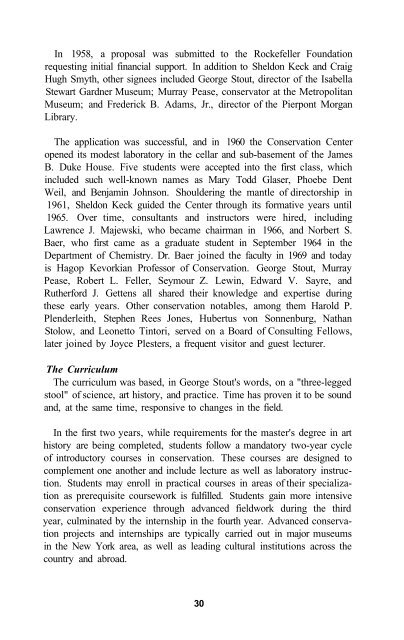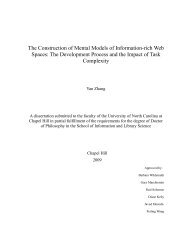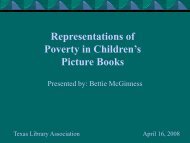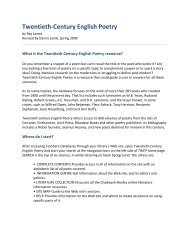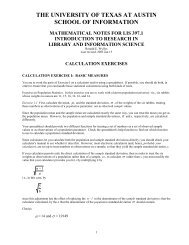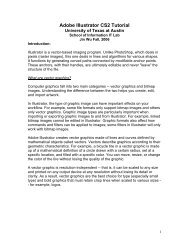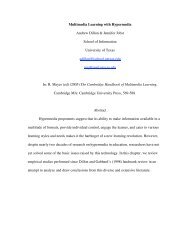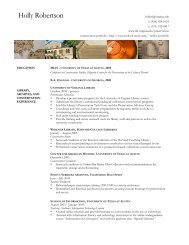North American Graduate Programs in the Conservation of
North American Graduate Programs in the Conservation of
North American Graduate Programs in the Conservation of
Create successful ePaper yourself
Turn your PDF publications into a flip-book with our unique Google optimized e-Paper software.
In 1958, a proposal was submitted to <strong>the</strong> Rockefeller Foundation<br />
request<strong>in</strong>g <strong>in</strong>itial f<strong>in</strong>ancial support. In addition to Sheldon Keck and Craig<br />
Hugh Smyth, o<strong>the</strong>r signees <strong>in</strong>cluded George Stout, director <strong>of</strong> <strong>the</strong> Isabella<br />
Stewart Gardner Museum; Murray Pease, conservator at <strong>the</strong> Metropolitan<br />
Museum; and Frederick B. Adams, Jr., director <strong>of</strong> <strong>the</strong> Pierpont Morgan<br />
Library.<br />
The application was successful, and <strong>in</strong> 1960 <strong>the</strong> <strong>Conservation</strong> Center<br />
opened its modest laboratory <strong>in</strong> <strong>the</strong> cellar and sub-basement <strong>of</strong> <strong>the</strong> James<br />
B. Duke House. Five students were accepted <strong>in</strong>to <strong>the</strong> first class, which<br />
<strong>in</strong>cluded such well-known names as Mary Todd Glaser, Phoebe Dent<br />
Weil, and Benjam<strong>in</strong> Johnson. Shoulder<strong>in</strong>g <strong>the</strong> mantle <strong>of</strong> directorship <strong>in</strong><br />
1961, Sheldon Keck guided <strong>the</strong> Center through its formative years until<br />
1965. Over time, consultants and <strong>in</strong>structors were hired, <strong>in</strong>clud<strong>in</strong>g<br />
Lawrence J. Majewski, who became chairman <strong>in</strong> 1966, and Norbert S.<br />
Baer, who first came as a graduate student <strong>in</strong> September 1964 <strong>in</strong> <strong>the</strong><br />
Department <strong>of</strong> Chemistry. Dr. Baer jo<strong>in</strong>ed <strong>the</strong> faculty <strong>in</strong> 1969 and today<br />
is Hagop Kevorkian Pr<strong>of</strong>essor <strong>of</strong> <strong>Conservation</strong>. George Stout, Murray<br />
Pease, Robert L. Feller, Seymour Z. Lew<strong>in</strong>, Edward V. Sayre, and<br />
Ru<strong>the</strong>rford J. Gettens all shared <strong>the</strong>ir knowledge and expertise dur<strong>in</strong>g<br />
<strong>the</strong>se early years. O<strong>the</strong>r conservation notables, among <strong>the</strong>m Harold P.<br />
Plenderleith, Stephen Rees Jones, Hubertus von Sonnenburg, Nathan<br />
Stolow, and Leonetto T<strong>in</strong>tori, served on a Board <strong>of</strong> Consult<strong>in</strong>g Fellows,<br />
later jo<strong>in</strong>ed by Joyce Plesters, a frequent visitor and guest lecturer.<br />
The Curriculum<br />
The curriculum was based, <strong>in</strong> George Stout's words, on a "three-legged<br />
stool" <strong>of</strong> science, art history, and practice. Time has proven it to be sound<br />
and, at <strong>the</strong> same time, responsive to changes <strong>in</strong> <strong>the</strong> field.<br />
In <strong>the</strong> first two years, while requirements for <strong>the</strong> master's degree <strong>in</strong> art<br />
history are be<strong>in</strong>g completed, students follow a mandatory two-year cycle<br />
<strong>of</strong> <strong>in</strong>troductory courses <strong>in</strong> conservation. These courses are designed to<br />
complement one ano<strong>the</strong>r and <strong>in</strong>clude lecture as well as laboratory <strong>in</strong>struction.<br />
Students may enroll <strong>in</strong> practical courses <strong>in</strong> areas <strong>of</strong> <strong>the</strong>ir specialization<br />
as prerequisite coursework is fulfilled. Students ga<strong>in</strong> more <strong>in</strong>tensive<br />
conservation experience through advanced fieldwork dur<strong>in</strong>g <strong>the</strong> third<br />
year, culm<strong>in</strong>ated by <strong>the</strong> <strong>in</strong>ternship <strong>in</strong> <strong>the</strong> fourth year. Advanced conservation<br />
projects and <strong>in</strong>ternships are typically carried out <strong>in</strong> major museums<br />
<strong>in</strong> <strong>the</strong> New York area, as well as lead<strong>in</strong>g cultural <strong>in</strong>stitutions across <strong>the</strong><br />
country and abroad.<br />
30


